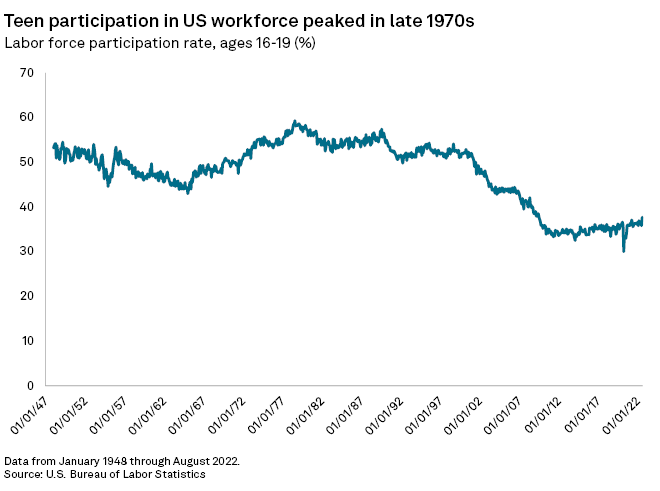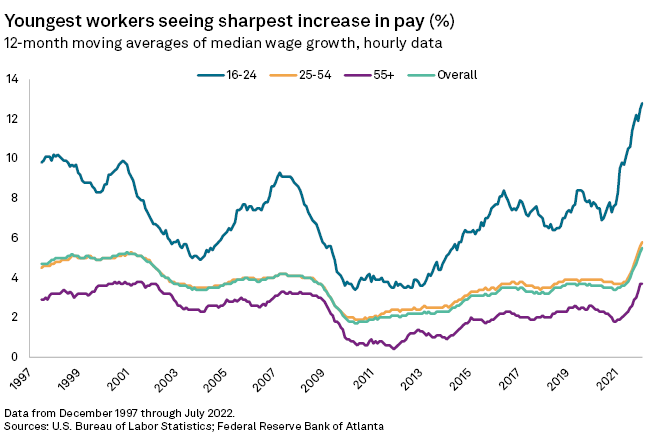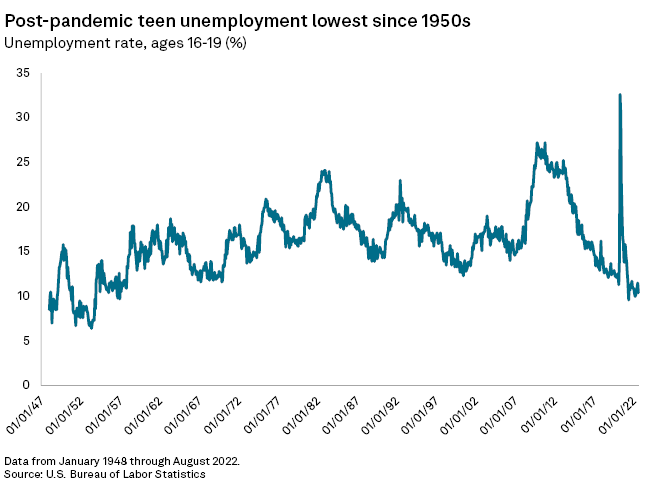S&P Global Offerings
Featured Topics
Featured Products
Events
S&P Global Offerings
Featured Topics
Featured Products
Events
S&P Global Offerings
Featured Topics
Featured Products
Events
Banking & Capital Markets
Economy & Finance
Energy Transition & Sustainability
Technology & Innovation
Podcasts & Newsletters
Banking & Capital Markets
Economy & Finance
Energy Transition & Sustainability
Technology & Innovation
Podcasts & Newsletters
S&P Global Offerings
Featured Topics
Featured Products
Events
8 Sep, 2022

By Brian Scheid

|
While nowhere near the levels of the late 1970s, more teenage Americans are joining the workforce than have done so in years. |
An extraordinarily tight labor market has forced U.S. employers to lean hard on Generation Z for help.
|
Businesses, particularly in the service and retail industries, are hiring teenagers at a frenzied pace after the pandemic upended their staffing plans. Teens have joined the workforce at the highest levels in at least a decade, with a nearly unlimited number of jobs from which to choose.
The labor force participation rate — the number of potential workers in the population who are employed or seeking work — for 16- to 19-year-olds averaged 36.6% through the first eight months of 2022. That is an increase of more than 380,000 workers from the same period in 2019.
Since the height of the pandemic, the participation rate for teens has climbed to its highest level since 2009, although it remains well below the peak of teen participation, which reached 58.6% in 1979.
"Employers are rediscovering young people as a source of labor," said Alicia Sasser Modestino, a professor and labor economist at Northeastern University. "Almost any teen can get a job right now. Some can even be choosy."
The great motivator
The big move of teens into the job market became apparent in the second half of 2021, as the service economy reopened and restaurants, hotels and other businesses were unprepared with multiple staffing positions unfilled.

Adults hesitated to return to the workforce following the pandemic for a variety of reasons, including health concerns, rude customers and limited options for childcare. In addition, many workers were given "battlefield promotions," Modestino said, as waves of workers were moved to management positions that grocery stores, restaurants and other businesses found suddenly vacated.
Melanie Rios, a high school junior from Bergen County, N.J., was not even sure she was going to get a job over the summer, with a travel soccer team and test prep classes taking up much of her time. She ended up taking two jobs: a retail position at a nearby mall for nearly $20 per hour and babysitting on weekend nights for $17 per hour.
"I'm a lot more busy than I planned," Rios said. "But the money is good."

Money has likely been the major factor attracting teens into the job market, with starting salaries at $20 per hour in many places and some businesses offering signing bonuses and flexible hours.
The 12-month moving average of median wages for workers aged 16 to 24 increased 12.8% in July, according to the Bureau of Labor Statistics and the Federal Reserve Bank of Atlanta, well above the 5.5% average increase for workers aged 25 through 54, the largest labor pool.

The push to hire teens has led to the lowest unemployment rate among 16- to 19-year-olds since the 1950s. The unemployment rate for these teens averaged 10.6% through the first eight months of 2022, compared to 12.8% over the same stretch of 2019.
'Finding gold'
Finding reliable workers for Crossroads Bar & Grill and the neighboring Crossroads Ice Cream Parlor has been a constant challenge, according to Austin Ross, who owns the two businesses in Onalaska, Wis.
Hiring dependable cooks and other kitchen staff has been "like finding gold," Ross said, as older workers are no longer interested in the relatively long hours and low pay that restaurant work offers. Instead, Ross now depends heavily on teenage workers. Roughly 90% of Ross' employees are under the age 20.
This has created its own set of problems, Ross said. While there are exceptions, teen workers tend to put in minimal effort and have tenuous attachments to their jobs. Many are distracted by aspirations to be social media influencers or YouTube stars.
"It's just the current state of the world that we live in," Ross said.
Still, many restaurateurs say they would have had a hard time staying open without the influx of younger workers.
"Teens saved the restaurant industry," said AnnElizabeth Konkel, a senior economist at Indeed. "A lot of these businesses ... if they didn't have teen workers, they likely wouldn't have survived."
College admissions trap
The question many economists are asking now is, "Will these trends last?"
With the pressure to gain admission to prestigious colleges higher than ever, many teens, and their parents, are more focused on developing a well-rounded academic and extracurricular résumé than on gaining workplace experience by flipping burgers or selling frocks.
"The nature of education has changed," Konkel said.
Teens with competitive sports, play rehearsals or band practices after school, in addition to hours of homework, have less scope for part-time work. In addition, far more teens are completing high school than were 40 years ago, reducing their incentives to join the workforce.
Until recently, jobs were also not as plentiful, as teens competed with older Americans, new immigrants and others for relatively low-wage jobs that did not require much experience. That changed as the pandemic altered employers' views on whom they were willing to hire.
Still, businesses face ongoing worker shortages. While the rate for teens has risen above pre-pandemic levels, the overall participation rate has yet to recover as older workers leave the workforce. The overall labor force participation rate was 62.4% in August, down from 63.4% in February 2020. That would indicate the tide of teen workers is unlikely to ebb.
"I think this is a permanent change," said Gus Faucher, chief economist at PNC Financial Services Group. "The labor force is structurally tighter now than it was pre-pandemic. Therefore, businesses will continue to hire younger people given the dearth of older available workers."
